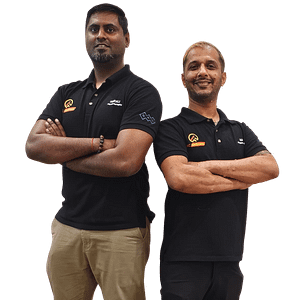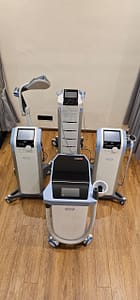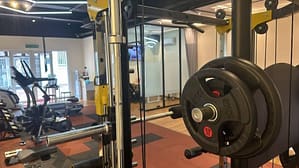Frequently Asked Questions
How can I become a physiotherapist?
To become a physiotherapist, you need to earn a bachelor's degree in physiotherapy or a related field, complete relevant clinical training, and obtain the necessary licensure or certification required in your region.
What can physiotherapists do?
Physiotherapists specialize in diagnosing and treating musculoskeletal conditions, promoting recovery, and improving mobility through personalized therapy techniques, including hands-on methods like IASTM. They play a crucial role in alleviating pain and enhancing overall physical function.
How do I become a physiotherapist?
To become a physiotherapist, you typically need to complete a relevant bachelor’s degree in physiotherapy, followed by obtaining necessary licenses and certifications to practice in your region.
What education is needed for physiotherapy?
The education required for physiotherapy includes obtaining a bachelor's degree in physiotherapy or a related field, followed by a master's degree or doctorate in physical therapy. Additionally, hands-on clinical experience and licensure are essential to practice as a physiotherapist.
Which skills are essential for physiotherapists?
The essential skills for physiotherapists include strong communication, critical thinking, and manual therapy techniques. Additionally, empathy and problem-solving abilities are crucial for effectively assessing and treating patients' diverse conditions.
What are common physiotherapy treatment methods?
Common physiotherapy treatment methods include manual therapy, exercise therapy, modalities like ultrasound and electrical stimulation, dry needling, and IASTM (Instrument Assisted Soft Tissue Mobilization), all aimed at relieving pain and promoting recovery.
How long does physiotherapy training take?
The duration of physiotherapy training typically takes about 3 to 4 years for a bachelor's degree, followed by an additional 1 to 2 years for a master's degree, depending on the country's requirements and the specific program chosen.
What certifications are required for physiotherapists?
The certifications required for physiotherapists typically include a degree in physiotherapy and a recognized license to practice, depending on the country. Additional certifications may be pursued for specialized areas of treatment.
How can physiotherapy help with rehabilitation?
Physiotherapy plays a crucial role in rehabilitation by facilitating recovery through tailored exercises, manual therapy, and pain management strategies. It enhances mobility, strengthens muscles, and promotes healing, allowing individuals to regain functionality and improve their quality of life.
What conditions do physiotherapists treat most often?
Physiotherapists most often treat conditions such as muscle pain, joint injuries, chronic pain, sports-related injuries, and post-surgical rehabilitation. These professionals utilize various techniques, including IASTM therapy, to promote recovery and improve mobility.
What is the role of physiotherapy in sports?
The role of physiotherapy in sports involves enhancing athletic performance, preventing injuries, and facilitating recovery. It employs various techniques to optimize physical function and ensure athletes maintain peak physical condition.
How does physiotherapy support pain management?
Physiotherapy supports pain management by utilizing various techniques, such as manual therapy, exercise prescription, and IASTM therapy, to enhance mobility, reduce pain perception, and promote healing of affected tissues, ultimately improving overall function and quality of life.
What are the steps to becoming a physiotherapist?
The steps to becoming a physiotherapist include obtaining a relevant undergraduate degree, completing a master's in physiotherapy, gaining clinical experience through internships, and passing the licensing examination to practice professionally.
Where can I find physiotherapy courses?
You can find physiotherapy courses through universities, online educational platforms, and professional organizations. Websites like Coursera, LinkedIn Learning, and local colleges offer a variety of accredited programs to enhance your skills in physiotherapy.
What is the difference between physiotherapy and chiropractic?
The difference between physiotherapy and chiropractic lies in their approach to treatment. Physiotherapy focuses on improving mobility and function through exercises and modalities, while chiropractic emphasizes spinal adjustments to alleviate pain and correct alignment.
How effective is physiotherapy for chronic pain?
The effectiveness of physiotherapy for chronic pain is significant, as it helps alleviate discomfort and improve mobility through personalized treatment plans, fostering recovery and long-term management of pain conditions.
What tools do physiotherapists commonly use?
The tools that physiotherapists commonly use include ultrasound machines, electrical stimulation devices, therapeutic exercise equipment, and modalities like IASTM tools for soft tissue mobilization, aiding in pain relief and recovery.
Can I specialize in a specific physiotherapy area?
Specializing in a specific physiotherapy area is possible. Many physiotherapists choose to focus on areas such as orthopedics, pediatrics, or sports rehabilitation to enhance their expertise and better serve their clients' needs.
What are the job opportunities for physiotherapists?
The job opportunities for physiotherapists include positions in hospitals, private clinics, rehabilitation centers, sports organizations, and home health care settings, focusing on patient care, treatment plans, and rehabilitation programs.
How does physiotherapy aid injury recovery?
Physiotherapy aids injury recovery by promoting healing through tailored exercises, manual therapy, and advanced techniques like IASTM. These approaches alleviate pain, restore movement, and strengthen affected areas, facilitating a quicker and more effective recovery process.
What patient outcomes can be expected from physiotherapy?
The expected patient outcomes from physiotherapy include reduced pain, improved mobility, enhanced strength, and better overall function. These results contribute to faster recovery and a higher quality of life for individuals dealing with various physical conditions.
What offline resources can help in physiotherapy studies?
Offline resources that can aid in physiotherapy studies include textbooks, professional journals, workshops, anatomy models, and collaborative study groups. These resources provide valuable insights and practical knowledge essential for understanding techniques and patient care in physiotherapy.
How can I prepare for a physiotherapy career?
Preparing for a physiotherapy career involves obtaining a relevant degree, gaining practical experience through internships, and developing strong communication and analytical skills to assist patients effectively in their recovery.
What advances are there in physiotherapy techniques?
Advances in physiotherapy techniques include the integration of innovative methods such as IASTM (Instrument Assisted Soft Tissue Mobilization), which enhances recovery, reduces pain, and improves mobility through targeted treatment of soft tissue conditions.
How do physiotherapists assess patient needs?
Physiotherapists assess patient needs by conducting thorough evaluations, including discussions about medical history, physical examinations, and functional assessments, allowing them to create personalized treatment plans to effectively address individual concerns and promote healing.
What are the challenges faced by physiotherapists?
The challenges faced by physiotherapists include managing diverse patient needs, staying updated with evolving treatment techniques, dealing with emotional and physical demands of patients, and navigating healthcare system constraints.
How can physiotherapy enhance athletic performance?
Physiotherapy can enhance athletic performance by improving flexibility, strength, and coordination, as well as addressing and preventing injuries. This comprehensive approach helps athletes optimize their physical capabilities and achieve peak performance.
What integrative approaches do physiotherapists use?
Integrative approaches used by physiotherapists include manual therapy, exercise prescription, and modalities like ultrasound or electrical stimulation, combining these techniques to enhance recovery, reduce pain, and improve functional mobility for various patient conditions.
What continuing education options exist for physiotherapists?
Continuing education options for physiotherapists include workshops, online courses, certification programs, and specialized training in areas like dry needling or IASTM, enabling them to stay updated with the latest techniques and improve patient care.
How can physiotherapists work with other health professionals?
Physiotherapists can collaborate with other health professionals by sharing insights and treatment plans, coordinating care, and referring patients as needed, ensuring a holistic approach to optimize patient recovery and well-being.







